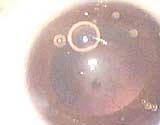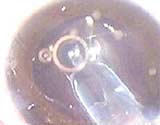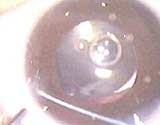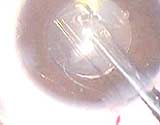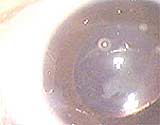Double IOL technique solves some myopic shifts in infants
MUMBAI, India – Double IOL implantation in infants following cataract surgery may allow surgeons to control the inevitable myopic shift that occurs as these patients age.
A problem when performing IOL surgery on infants is obtaining subsequent refractive accuracy. Either the implant is improper and will eventually result in a high degree of hyperopia, or there may be problems fitting the child with secondary contact lenses, said Keiki R. Mehta, MD, of the Mehta International Eye Institute here.
Selecting an appropriate implant for these children is a difficult venture. For example, a newborn or a 6-month-old infant has an IOL power calculated at approximately 31 D, but in a year’s time, the power will drop to almost 21 D.
"Even if you do the cataract surgery successfully, are you getting a visual result with any level of success?" Dr. Mehta asked.
Dr. Mehta’s method involves piggybacking a HEMA removable IOL lens in front of a permanent AcrySof (Alcon) lens. The HEMA IOL can be easily removed and does not induce any adhesions. HEMA can also be made in the shape of an inverted dome so it is easily inserted into the capsular bag, Dr. Mehta said.
|
|
|
|
|
|
|
|
|
|
||
Study
Sixteen children (27 eyes) received 3 years of follow-up with subsequent HEMA disc removal. Implantations occurred between 2 and 15 months of age. Two of the children had a silicone IOL reimplanted in place of the HEMA for excess residual ametropia. Reactions were negligible and no adhesions were seen with the HEMA-AcrySof combination. The HEMA lens, made with an extremely high purity content, is manufactured by IOLTECH India Ltd.
Total IOL power is calculated using the SRK-T formula. With this extrapolated, anticipated IOL power, the AcrySof lens is placed in the bag, with the residual power of a HEMA lens placed in front of it. The HEMA lens is essentially 9.5 mm in diameter with a 5-mm optic on the external side allowing for easy injection through a 3.4-mm opening. Removal is just as simple via a 3.5-mm incision, and is performed when the anticipated IOL refraction reaches 4 D.
Surgery specifics
A corneal tunnel incision is made with a diamond knife. With infants, Dr. Mehta said, it is important to put a final stitch at the end. Because of the scleral rigidity factor, it does not seal and tends to leak. Capsulorrhexis, hydrodissection and phaco are performed, with cataract fragments then aspired out. A posterior capsulorrhexis is then conducted with Ultrata forceps. The incision is widened, with a Monarch injector used to inject the AcrySof lens. The HEMA domed IOL implant is inserted using forceps; the IOL’s beveled edge allows for easier entrance. The rim should be inserted under both the edge of the iris and the edge of the capsulorrhexis. Both the AcrySof lens and the HEMA IOL will now lie under the capsulorrhexis zone.
Issues for study
Much investigation and follow-up still needs to be conducted.
"We still need to be able to calculate better exactly what is happening. It is the calculation of the initial residual part where the problem lies," Dr. Mehta said.
One of the biggest procedural complications is a temporal rise in IOP, but after approximately 36 months of follow-up, almost 96% of the study cases are within 3 D accuracy.
For Your Information:
- Keiki R. Mehta, MD, can be reached at Mehta Int. Eye Institute, 147 Shahid Bhagat Singh Rd., Mumbai 400005, India; +(91) 22-215-0082; fax: +(91) 22-215-0433; e-mail: keiki_mehta@yahoo.com. Ocular Surgery News could not confirm whether Dr. Mehta has a direct financial interest in any of the products mentioned of if he is a paid consultant for any company mentioned.
- Alcon, makers of the AcrySof, can be reached at 6201 South Freeway, Fort Worth, TX 76134 U.S.A.; +(1) 817-293-0450; fax: +(1) 817-568-6142.
- IOLTECH, makers of the HEMA IOL, can be reached at Avenue Paul Langevin, BP 5, 17053 La Rochelle Cedex 9, France; +(33) 5-46-44-85-50; fax: +(33) 5-46-44-85-60.

